Denpasar
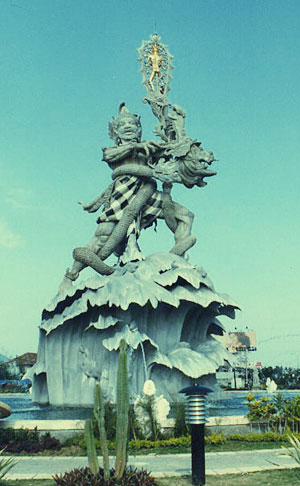 Denpasar is Bali's capital city. Although the modern centre of
government departments, international banks, and many other offices, it
still retains its unique Balinese personality. This is strongly felt and
clearly seen in its many temples, universities and pleasant gardens,
which still maintain their presence and influence. Denpasar has the Pura
Jagatnatha, a temple dedicated to Bali's Supreme God, Sang Hyang Widi.
There are interesting statues of a turtle and two mystical dragons in
the temple, signifying the foundation of the world. The Pura's awesome
architecture resembles that of Balinese palace. It has now been
converted into a museum housing a fine collection of prehistoric and
modern art. The famous 4th century Pura Maospahit, is right next to Pura
Jaganatha.
Denpasar is Bali's capital city. Although the modern centre of
government departments, international banks, and many other offices, it
still retains its unique Balinese personality. This is strongly felt and
clearly seen in its many temples, universities and pleasant gardens,
which still maintain their presence and influence. Denpasar has the Pura
Jagatnatha, a temple dedicated to Bali's Supreme God, Sang Hyang Widi.
There are interesting statues of a turtle and two mystical dragons in
the temple, signifying the foundation of the world. The Pura's awesome
architecture resembles that of Balinese palace. It has now been
converted into a museum housing a fine collection of prehistoric and
modern art. The famous 4th century Pura Maospahit, is right next to Pura
Jaganatha.There is also an interesting place like; the government-supervised art centre, Sanggraha Kriya Hasta, which also home to a tremendous variety of handicraft and works of art. Taman Wedhi Budaya, meanwhile, is an arts centre with occasional exhibits of paintings, crafts and carvings, and holds traditional dances every evening. It is also the host of the annual Bali Arts Festival in June to July, with performances, exhibitions, art contest, and other activities of artistic nature.
The main street of Denpasar start with Gajah Mada Street in the west, Surapati Street in the centre, followed by Hayam Wuruk Street and ends as Raya Sanur Street in the east. There are many things of history and culture to see. The Puputan Square, with its heroic Catur Mukha, fondly commemorates the Balinese's suicidal stand against the Dutch. Until today, it is touchingly, a popular meeting place for locals in the evenings.
Kintamani
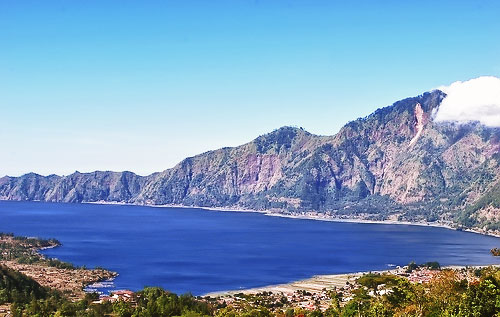 The villages of Kintamani and Penelokan provide a great view of
the still active Mount Batur and its fantastic lake. Seven miles in
diameter and sixty feet deep, Batur caldera is simply astounding. From
Penelokan, take the road Kedisan on the shores of the lake where boats
can be rented to cross over to Trunyan. The spectacular mountainous
region around Kintamani with its deep Crater Lake and bubbling hot
springs, make this region a must to visit. Batur Lake is the largest
lake in Bali and the region offers some of the most spectacular views to
be found anywhere on the island. Batur Lake also provides water for an
underground network of streams and springs across the southern slopes of
the mountain. Kintamani is really great for day trips, trekking or
simply for getting away from it all for a few days.
The villages of Kintamani and Penelokan provide a great view of
the still active Mount Batur and its fantastic lake. Seven miles in
diameter and sixty feet deep, Batur caldera is simply astounding. From
Penelokan, take the road Kedisan on the shores of the lake where boats
can be rented to cross over to Trunyan. The spectacular mountainous
region around Kintamani with its deep Crater Lake and bubbling hot
springs, make this region a must to visit. Batur Lake is the largest
lake in Bali and the region offers some of the most spectacular views to
be found anywhere on the island. Batur Lake also provides water for an
underground network of streams and springs across the southern slopes of
the mountain. Kintamani is really great for day trips, trekking or
simply for getting away from it all for a few days.The district is the earliest known kingdom in Bali, dating from the tenth century. The evenings get cool up here but it's well worth the stay overnight to climb the volcano and watch the sunrise. Many cheap cottages are available here.
Kintamani can run through Payangan or from Denpasar through the Sangeh monkey forest, Plaga and Lampu, arriving to the north of Kintamani. Bemos to Kintamani are available from Ubud via Sakah (notable for its huge "Baby" statue). They also run via Tampaksiring and Bangli. From Denpasar bemos leave for Kintamani from the Batubulan terminal until late afternoon.
Tour to Kintamani is a very impressive experience where Kintamani Area have very beautiful panorama located in plateau and also encircled by mountain atmosphere with the windblast from Mount Batur. Carpet of Batur Lake seen far below and also there are local resident house beside of Batur Lake. Beside of that, Mount Batur which to date still be active growing its beautiful for Kintamani Area.
Ubud
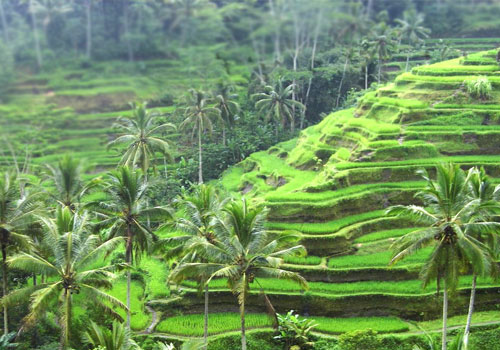 Ubud is Bali's cultural heart. This area is located in the cool
mountains, just one hour's drive north of the airport and the resorts of
southern Bali, this traditional country town is the home of the
Balinese Royal family and a flourishing arts centre. Most of Bali's
museums and galleries are centered in Ubud, but culture and history rich
Bali is peppered with museums and galleries. These museums and
galleries offer paintings, woodcarvings, textiles and all kinds of
souvenirs for viewing and also purchase. Puri Lukisan Museum in centre
of Ubud, Neka Museum in Campuhan, Seniwati Gallery and Agung Rai Museum
in Pengosekan is a must, to see the difference between creative art and
more commercial products.
Ubud is Bali's cultural heart. This area is located in the cool
mountains, just one hour's drive north of the airport and the resorts of
southern Bali, this traditional country town is the home of the
Balinese Royal family and a flourishing arts centre. Most of Bali's
museums and galleries are centered in Ubud, but culture and history rich
Bali is peppered with museums and galleries. These museums and
galleries offer paintings, woodcarvings, textiles and all kinds of
souvenirs for viewing and also purchase. Puri Lukisan Museum in centre
of Ubud, Neka Museum in Campuhan, Seniwati Gallery and Agung Rai Museum
in Pengosekan is a must, to see the difference between creative art and
more commercial products.Inspired by vibrant green rice paddies, mountains and colorful Balinese festivals, the elite artistic colony that began in the 1930's with eminent European painters, writers and musicians has now grown into a thriving arts centre, drawing increasing numbers of visitors. Ubud is also a flourishing crafts centre. Around Ubud the surrounding villages like Camphuan, Penestanan, Peliatan and Batuan specializing in crafts and woodcarving which are sold all over the island. There are hundreds of shops selling antiques, woodcarvings, crafts, textiles, paintings and jewelry as well as some of the best art museums in the country, dozens of art studios, an excellent local craft market, and galleries selling local and international art.
Ubud's role as the epicenter of Balinese culture makes it the perfect place to see traditional Balinese dance and drama. From the early 1920's the royal family ensured that most talented teachers of dance, music and drama were brought to Ubud to entertain the King and pass on their knowledge. Dances like Legong, Ramayana, Baris, Kecak and Sanghyang (the fire dance) are performed nightly in Bona village, just 15 minutes drive from Ubud. Bali's most accomplished dancers, musicians, painters and carvers live in just 10 square kilometers.
Balinese Hinduism remains stronger in Ubud than elsewhere in Bali, cremation ceremony or celebration of some kind. Balinese Hinduism is distinct from that of India and has absorbed the animism of Bali's pre-Hindu ancestors - inspired by the extraordinary beauty of Bali's landscapes - rice fields, mountains, river gorges, villages and ancient temples.
Visit Ubud Monkey Forest, a natural forest reserve popular with both locals and tourists. Inhabited by wild monkeys who will steal the camera, bananas, handbags, toupees, etc. These mischievous monkeys provide lots of entertainment. Interesting meandering paths lead to charming places like the bathing temple surrounded by lush remnants of ancient forest. Just off the main square a lovely arched stone bridge leads to the Hindu elephant-headed Lord Ganesh overlooking a small, square, moss-covered pool where several koi swim at his feet.
Trunyan
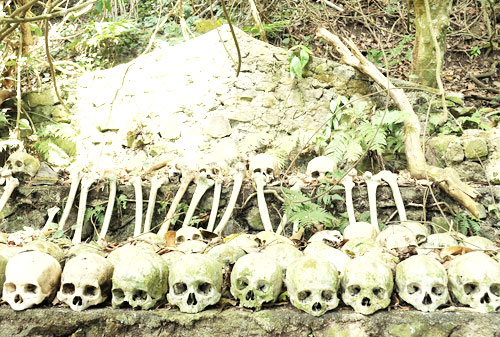 Trunyan is another ancient village inhabited by people who call
themselves the “Bali Aga” or old Bali who live in ways that are vastly
different from other Balinese. The Bali Aga's temple in this village is
named Puser Jagat, meaning Navel of the Universe. Its architecture is
highly unusual, and stands in the protective shade of a massive banyan
tree.
Trunyan is another ancient village inhabited by people who call
themselves the “Bali Aga” or old Bali who live in ways that are vastly
different from other Balinese. The Bali Aga's temple in this village is
named Puser Jagat, meaning Navel of the Universe. Its architecture is
highly unusual, and stands in the protective shade of a massive banyan
tree.The Bali Aga has a strange way of burial. Instead of cremating their corpses, the Bali Aga simply places them under this banyan tree. The odor is mysteriously masked by a special arboreal fragrance emitted by the banyan tree.
The village of Trunyan is squeezed tightly between the lake and the outer crater rim of Batur, an almighty volcano in Kintamani. This is a Bali Aga village, inhabited by descendants of the original Balinese, the people who predate the arrival of the Hindu Majapahit kingdom in the 16th century. It is famous for the Pura Pancering Jagat temple, but unfortunately visitors are not allowed inside. There is also a couple of traditional Bali Aga-style dwellings, and a large banyan tree, which is said to be more than 1,100 years old. At Kuban sub-village close to Trunyan is a mysterious cemetery that is separated by the lake and accessible only by boat, there is no path along the steep walls of the crater rim.
Unlike the Balinese people, Trunyan people do not cremate or bury their dead, but just lay them out in bamboo cages to decompose, although strangely there is no stench. A macabre collection of skulls and bones lies on the stone platform and the surrounding areas. The dead bodies don't produce bad smells because of the perfumed scents from a huge Taru Menyan tree growing nearby. Taru means 'tree' and Menyan means 'nice smell'. The name of Trunyan was also derived from these two words. The women from Trunyan are prohibited from going to the cemetery when a dead body is carried there. This follows the deeply rooted belief that if a woman comes to the cemetery while a corpse is being carried there, there will be a disaster in the village, for example a landslide or a volcanic eruption. Such events have been frequent in the village's history, but whether women had anything to do with it is a matter of opinion.
Sanur Beach
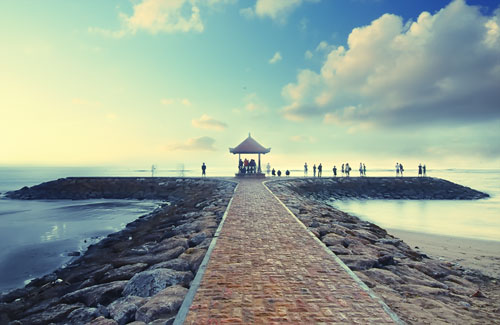 Sanur is one of Bali's biggest traditional villages but it's
also one of the most established tourist areas. Sanur was Bali's first
beach resort but still retains its Balinese character and old style
village ambiance. On the southeastern side of Bali, Sanur beach is
easily reachable from Denpasar, about a 5 to 10 minute drive. Sanur is
an excellent site to watch the sun rises, as we jog along the white
sandy beach. Being one of the first resorts developed in Bali, Sanur
maintains its traditions. Only a stone thrown away from the beach,
ancient temples stand as solemn as they have been in centuries past.
Sanur is one of Bali's biggest traditional villages but it's
also one of the most established tourist areas. Sanur was Bali's first
beach resort but still retains its Balinese character and old style
village ambiance. On the southeastern side of Bali, Sanur beach is
easily reachable from Denpasar, about a 5 to 10 minute drive. Sanur is
an excellent site to watch the sun rises, as we jog along the white
sandy beach. Being one of the first resorts developed in Bali, Sanur
maintains its traditions. Only a stone thrown away from the beach,
ancient temples stand as solemn as they have been in centuries past.Palm-lined beach, facing the Indian Ocean towards the east, Sanur is an excellent place to see the sun rise in the morning. "Bali is the morning of the world", it is the right sentence for Bali if we has visited Sanur. Offshore reefs protect the beach against the waves, and make it popular for windsurfing, boating, and other water sports. It is one of the first areas where one can find good hotels, restaurants, shops, and other tourist facilities.
It's also the place for some of Bali chic fashion shops, hot hotels and well-known restaurants. It is a good location to explore the rest of Bali. Fine hotels, restaurants and modern entertainment venues complement traditional village activities like drama and dance, so it's a good place to enjoy the delights of a tropical island and gain a real appreciation of Balinese culture and local life. Gradual and early development has meant that Sanur has grown alongside the village, with hotels located right next door to local meeting halls and Brahmanic temples. Many hotels have expansive gardens that face the ocean in a picturesque unbroken seaside promenade.
Kuta Beach
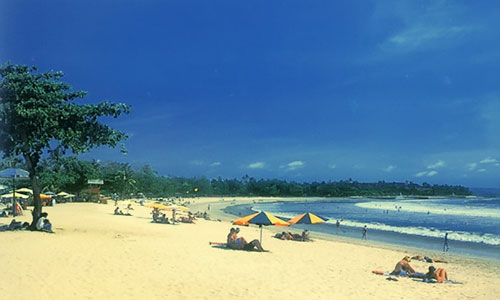 Once a lonely little village on the road from Denpasar to Bukit
Peninsula, Kuta is now the tourist Mecca of Bali, popular mainly among
the young and adventurous. Kuta beach is one of the first favorite
beaches discovered by tourist. Coconut trees line the sand beach as far
as the eyes can see towards the north stopped by the runway of
Denpasar's airport far in the west. The sunset in Kuta is most
breathtaking. On the south, the beach is fenced by the airport's runway,
which gives the visitors a breathtaking landing experience. Kuta Beach
bustles with tourists' vendors and locals. It's the most popular beach
in Bali and the island's number one party zone. The beach stretches as
far north as the eyes can see. As short walk away north, the waves will
invite to surfing. Rapid development and an influx of visitors haven't
kept the surfers away and Kuta still remains one of Bali's best surfing
beaches and a great place to enjoy a beach lifestyle.
Once a lonely little village on the road from Denpasar to Bukit
Peninsula, Kuta is now the tourist Mecca of Bali, popular mainly among
the young and adventurous. Kuta beach is one of the first favorite
beaches discovered by tourist. Coconut trees line the sand beach as far
as the eyes can see towards the north stopped by the runway of
Denpasar's airport far in the west. The sunset in Kuta is most
breathtaking. On the south, the beach is fenced by the airport's runway,
which gives the visitors a breathtaking landing experience. Kuta Beach
bustles with tourists' vendors and locals. It's the most popular beach
in Bali and the island's number one party zone. The beach stretches as
far north as the eyes can see. As short walk away north, the waves will
invite to surfing. Rapid development and an influx of visitors haven't
kept the surfers away and Kuta still remains one of Bali's best surfing
beaches and a great place to enjoy a beach lifestyle.While the surfers are still part of the Kuta scene, it's the shopping, nightlife and party vibes that attracts thousands of visitors. There's a huge choice of accommodation, restaurants and entertainment. The accommodation in Kuta range from a modest home stay for a few dollars a night to luxurious, five star, international hotels costing several hundred to several thousand dollars a night. Legian Street, situated directly behind the row of hotels that face the beach, is lined with shops of all varieties. We can find any Balinese handicrafts here, from the least expensive to the most exquisite; or unique stores such as the leather store staffed by two young Balinese men that will perfectly sculpt a leather jacket. (They are all extremely talented artists). _At night, Kuta is alive with night life. Western influences create discotheques, dance clubs, and pubs. Gastronomical demands inspire a multitude of restaurants, serving traditional Indonesian and Balinese food to various ethnic meals from Japan, Switzerland, etc. As if these were not enough, various Balinese dance performances are staged in Kuta every night. One of the best Kecak performances is found in Kuta.
Legian Beach
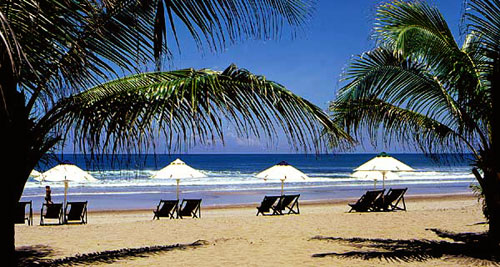 Close to the Kuta action but far enough for some down time,
Legian is less hectic than downtown Kuta but still has a funky nightlife
zone. Legian is a no-holds barred beach where locals, expatriates and
tourists mingle, bargain with the best, play paddle ball and football,
indulge in a massage and manicure, catch up on reading, meditate,
exercise. Legian and Seminyak were small villages a few years ago a
short distance from Kuta.
Close to the Kuta action but far enough for some down time,
Legian is less hectic than downtown Kuta but still has a funky nightlife
zone. Legian is a no-holds barred beach where locals, expatriates and
tourists mingle, bargain with the best, play paddle ball and football,
indulge in a massage and manicure, catch up on reading, meditate,
exercise. Legian and Seminyak were small villages a few years ago a
short distance from Kuta.Over the last few years, accommodation has expanded around Legian with many simple family-owned guest houses upgraded; complemented by boutique style hotels and first class hotels. Kuta is literally five-minute taxi ride away. Sunset is peak time at Legian Beach, when the beach bars fill up, the football field is at its busiest and the locals knock off work and wade fully clothed, skirts swirling, into the waves. Now part of the greater Kuta area, both offer quieter alternatives and a more sophisticated nightlife scene focusing on dining-out and socializing rather than full-on partying.
Jimbaran Beach
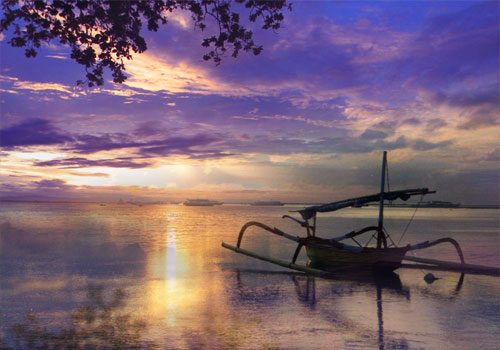 Jimbaran is directly south of the airport, on the way from
Denpasar towards Nusa Dua. Jimbaran village is the narrow neck of Bali
Island, and thus it has two remarkably different beaches. On the west,
Jimbaran Beach faces the Jimbaran Bay, recently lined by new luxurious
resorts. On the east, the beach faces the body of water sheltered by
Benoa Harbor. Jimbaran is a sleepy cove where fleets of fishing boats
color the scene. Formerly a relatively quiet area, its image has
improved dramatically with the opening of the beautiful Four Season's
Resort and the Inter-Continental. The last couple of years, it has
become even busier still with grilled seafood restaurants going up at a
rapid pace along the beach, attracting local families and tourists in
droves.
Jimbaran is directly south of the airport, on the way from
Denpasar towards Nusa Dua. Jimbaran village is the narrow neck of Bali
Island, and thus it has two remarkably different beaches. On the west,
Jimbaran Beach faces the Jimbaran Bay, recently lined by new luxurious
resorts. On the east, the beach faces the body of water sheltered by
Benoa Harbor. Jimbaran is a sleepy cove where fleets of fishing boats
color the scene. Formerly a relatively quiet area, its image has
improved dramatically with the opening of the beautiful Four Season's
Resort and the Inter-Continental. The last couple of years, it has
become even busier still with grilled seafood restaurants going up at a
rapid pace along the beach, attracting local families and tourists in
droves.Located on Bali's west coast, Jimbaran offers a small-secluded beach area, where tranquility and perfect peace is the perfect antidote to a stressful world. The land gently slopes away from the beach revealing exclusive celebrity haunts hidden under a canopy of leafy tropical forest. A popular spot for windsurfing and sailing small craft, which are available for rent, Jimbaran's grey sand and calm waters are attracting more people but the beach still has a sleepy feeling. A day at Jimbaran is made even more popular because of the all the wonderful options to eat. Choose from simple local food, the freshest fish or 5-star luxury. It is also a popular spot for sunset.
Nusa Dua
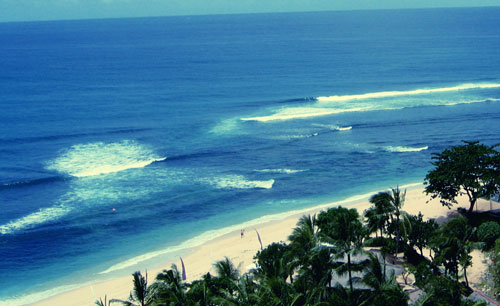 Bali's most prestigious resort area, Nusa Dua is where the
tourists will find international world, class luxury hotels elegantly
lining beautiful white sands. Located on the Bukit peninsula, in the
southern part of Bali, approximately 10 km from the international
airport. It is quiet and exclusive with superb facilities.
Bali's most prestigious resort area, Nusa Dua is where the
tourists will find international world, class luxury hotels elegantly
lining beautiful white sands. Located on the Bukit peninsula, in the
southern part of Bali, approximately 10 km from the international
airport. It is quiet and exclusive with superb facilities.Crystal clear water and stretches of white sandy beach of Nusa Dua makes Nusa Dua a perfect spot for luxurious resorts to which exhausted the bodies, after a Barong performance at Batubulan and a long climb of the steps of the Mother Temple Besakih, will want to rest. Some of the most sumptuous and luxurious hotels in the world find their home in Nusa Dua Bali. We can tee off into the sunset, while watching the gentle waves come from the blue sea and caress the banks surrounding the luscious greens. Tranquil swimming pools under the coconut trees seem to be one with the distant blue sea. Art galleries and numerous shops surround them.
Nusa Dua is really about taking it easy and relaxing in total luxury. As most of the hotels are 5 stars, every comfort is at our disposal as well as a gorgeous white sand beach. Nusa Dua was designed for the luxury conscious with a heavy concentration of big name hotels lining the beautiful white sand beach. The kind of activities on offer gives a flavor of Nusa Dua. The Bali Golf and Country Club, an immaculately landscaped 18 holes ocean view course. The Bali International Lawn Tennis & Lawn Bowls Club next to the Galleria Nusa Dua a spacious shopping mall with boutiques and up market restaurants. Close by Chandra Koka Amphitheatre provides a venue for traditional entertainment including arts festivals like the Nusa Dua Arts and Culture Festival. Stroll to the northern end of Nusa Dua for parasailing, jet skis, snorkeling/diving trips or better still, head for Tanjung Benoa.
Some of the resorts have private beaches but most areas are accessible. The stretch past the Hilton Resort has been a public beach and during the wet season, the outer reef there is a popular surf break. At present we will find some simple warungs selling good food at cheap prices along this beautiful stretch of white sandy beach that offers excellent swimming conditions in a protected lagoon.
Tanjung Benoa
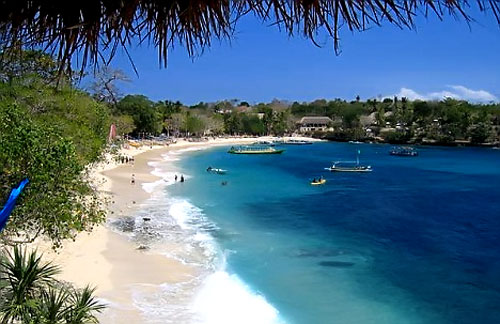 Tanjung Benoa, or the Benoa peninsula just north of Nusa Dua has
become much busier over the years and has a wide range of accommodation
including prestigious resorts like 'The Conrad'. Benoa peninsula is a
scenic 5 kilometers of coconut palms and fine sand. The area is the
almost exclusive home of luxury hotels, private villas, fine
restaurants, open-air cafes and water sports facilities. The resort has
become busier over recent years with more hotels Bali Resort and Spa
joining impressive resorts like the Aston Bali. The shape of the beach,
also makes Tanjung Benoa perfect for water sports with no shortage of
shops catering to marine sports enthusiasts.
Tanjung Benoa, or the Benoa peninsula just north of Nusa Dua has
become much busier over the years and has a wide range of accommodation
including prestigious resorts like 'The Conrad'. Benoa peninsula is a
scenic 5 kilometers of coconut palms and fine sand. The area is the
almost exclusive home of luxury hotels, private villas, fine
restaurants, open-air cafes and water sports facilities. The resort has
become busier over recent years with more hotels Bali Resort and Spa
joining impressive resorts like the Aston Bali. The shape of the beach,
also makes Tanjung Benoa perfect for water sports with no shortage of
shops catering to marine sports enthusiasts.Right at the tip of the peninsula is the quiet port of Tanjung Benoa, with its village like alleyways and rows of traditional fishing boats and yachts. Offshore "Turtle Island" is the site of a sacred sea temple. Tanjung Benoa has something for everyone -especially if we are a water sport fun. Snorkeling, diving, windsurfing, water skiing, powerboats, banana boats and reef fishing. (The reef is just 200 meters from the shoreline at the northeastern tip)
Sangeh Monkey Forest
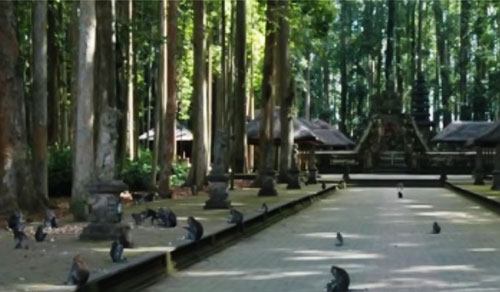 It is located near to Sangeh village; the renowned 6 hectares of
Bali Sangeh Monkey Forest are filled with giant nutmeg trees capable of
growing as high as 40m. Sangeh Monkey Forest near the village of
Sangeh, in southwestern Bali, has six hectares of forestland with giant
nutmeg trees. The main attractions here are the hordes of funny yet wise
Balinese monkeys inhabiting both the trees and the temple, Pura Bukit
Sari, found in the heart of the forest. The monkeys of the forest are
believed to be sacred and indeed will approach anyone paying respects at
the temple. But visitors should be aware that these monkeys are
attracted to shiny objects, so cameras and jeweler should be left behind
or kept well hidden under clothes or in a bag when exploring Sangeh
Bali.
It is located near to Sangeh village; the renowned 6 hectares of
Bali Sangeh Monkey Forest are filled with giant nutmeg trees capable of
growing as high as 40m. Sangeh Monkey Forest near the village of
Sangeh, in southwestern Bali, has six hectares of forestland with giant
nutmeg trees. The main attractions here are the hordes of funny yet wise
Balinese monkeys inhabiting both the trees and the temple, Pura Bukit
Sari, found in the heart of the forest. The monkeys of the forest are
believed to be sacred and indeed will approach anyone paying respects at
the temple. But visitors should be aware that these monkeys are
attracted to shiny objects, so cameras and jeweler should be left behind
or kept well hidden under clothes or in a bag when exploring Sangeh
Bali.Near Sangeh village, about 20 km north of Denpasar. This forest of approximately 6 hectares is filled with giant nutmeg trees that can grow up to 40m high. The main attractions are the hordes of Balinese monkeys that inhabit the trees and the temple, Pura Bukit sari, located in the heart of the forest. The temple, Pura Bukit Sari, was originally built around the 17th century as an agricultural temple and has been restored several times, most recently in 1973. In the central courtyard, a large statue of Garuda, an old carving of uncertain date, symbolizes freedom from suffering and the attainment of amerta, the elixir of life. The forest of nutmeg trees in which it lies was presumably planted deliberately a long time ago, for it is unique in Bali.
Besakih Temple (Mother Temple)
 Over a thousand years old, Besakih Temple is known as the
"Mother Temple of Bali" Perched on the slopes of Mount Agung, at a lofty
1,000 meters (3,000 feet). Besakih is the biggest and holiest of all
the Balinese temples. Bali's mother temple stands against a stupendous
mountain backdrop on the southeastern slopes of Mount Agung. Named after
the Dragon God believed to inhabit the mountain, it's said to be the
only temple where a Hindu of any caste can worship.
Over a thousand years old, Besakih Temple is known as the
"Mother Temple of Bali" Perched on the slopes of Mount Agung, at a lofty
1,000 meters (3,000 feet). Besakih is the biggest and holiest of all
the Balinese temples. Bali's mother temple stands against a stupendous
mountain backdrop on the southeastern slopes of Mount Agung. Named after
the Dragon God believed to inhabit the mountain, it's said to be the
only temple where a Hindu of any caste can worship.Eighteen separate sanctuaries belonging to different regencies and caste groups surround the three main temples dedicated to Shiva, Brahma and Vishnu. To the Balinese, visiting the temple sanctuaries is a special pilgrimage. The mountain top setting gives it an almost mystical quality. The largest on the island, this massive complex of 35 small temples attracts staggering numbers each year, being the main point of pilgrimage for Balinese Hindus. Steps ascend through split gates to the main courtyard where the Trinity shrines, dedicated to Shiva, Brahma, and Vishnu, are wrapped in cloth and decorated with flower offerings. There are number of temples but many of their inner courtyards are closed to visitors. Tracing its origins to prehistoric times, the complex was untouched by the great 1963 eruption of Mount Agung, which wiped out surrounding villages. The complex also houses the oldest remaining gamelan instrument in Bali called selonding. The temple ceremony (odalan) falls on the 10th month of the Balinese calendar, in April. If traveling, try to reach Pura Besakih before 9am, when many tourist buses start to arrive, so that we can take in the lovely temple in the quiet Balinese morning.
Tanah Lot Temple
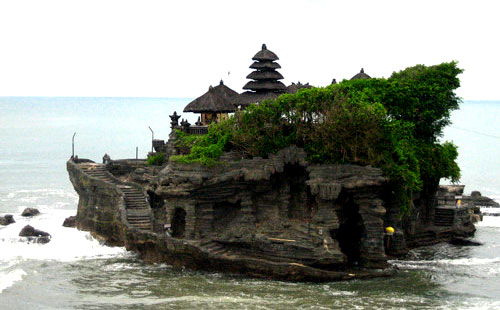 Tanah Lot is located about 12 kilometers from Tabanan City and
20 kilometers from Denpasar. The area comprises a wondrous mixture of
natural beauty and sheer human effort. Here lies an idyllic white sand
beach with crashing waves, complemented by a small yet majestic temple.
This temple, known as Pura Tanah Lot, juts out to sea on a rocky
background. Tanah Lot attracts throngs of both locals and tourists
daily. Most come here longing to catch a glimpse of the romantic Tanah
Lot sunsets, a regular occurrence during the dry season (April to
November).
Tanah Lot is located about 12 kilometers from Tabanan City and
20 kilometers from Denpasar. The area comprises a wondrous mixture of
natural beauty and sheer human effort. Here lies an idyllic white sand
beach with crashing waves, complemented by a small yet majestic temple.
This temple, known as Pura Tanah Lot, juts out to sea on a rocky
background. Tanah Lot attracts throngs of both locals and tourists
daily. Most come here longing to catch a glimpse of the romantic Tanah
Lot sunsets, a regular occurrence during the dry season (April to
November).The royal Taman Ayun temple was built by one of the last priests to come to Bali from Java in the 16th century. The temple stands on the top of a huge rock, surrounded by the sea and is one of Bali's most important sea temples. Tanah Lot pays homage to the guardian spirits of the sea. Ancient rituals pay homage to the guardian spirits of the sea. Poisonous sea snakes found in the caves at the base of the rocky island are believed to be guardians of the temple, standing Virgil against evil spirits and intruders. At the base of the rocky island are poisonous sea snakes believed to guard the temple from evil spirits and intruders. The best time to see Tanah Lot is in the late afternoon when the temple is in silhouette.
Tampak Siring
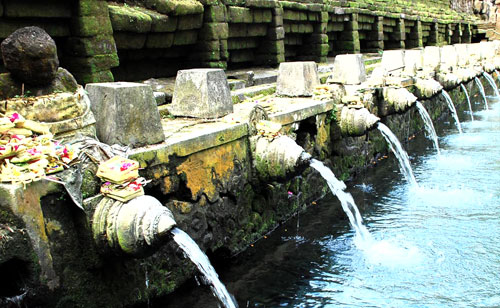 Pura Tirta Empul is the temple of Tampak Siring, built around a
sacred spring. Tampak Siring is an inscription dates the spring all the
way back to 926AD; and there are fine carvings and Garudas on the
courtyard buildings. The temple and its two bathing spots have been used
by the Balinese for over a thousand years for good health and
prosperity; as the spring water really does have the power to cure.
Regular purification ceremonies also take place here.
Pura Tirta Empul is the temple of Tampak Siring, built around a
sacred spring. Tampak Siring is an inscription dates the spring all the
way back to 926AD; and there are fine carvings and Garudas on the
courtyard buildings. The temple and its two bathing spots have been used
by the Balinese for over a thousand years for good health and
prosperity; as the spring water really does have the power to cure.
Regular purification ceremonies also take place here.A little off the main road in Tampaksiring is Mount Kawi with its group of large stone memorials cut into cliffs on either side of a picturesque river valley. It is believed to date from 11th century; one is of Bali's most impressive sights. Tampak Siring artists produce marvelous bone and ivory carvings. Both sites open daily. By public transport from Ubud, catch a bemo north to Tampaksiring from the junction in Bedulu, which is southeast of Ubud.
An archaeological complex lies on gorge of Pakerisan River. To reach the complex visitors must walk about 600 meters from the parking area to the ticket counter than walked down on 315 stone steps. Before take a cross on the bridge at the bottom of the valley make a turn to the left to see the first stone monument. Another group of stone monument is located on the left side of the main temple across of the river.
The monuments are hewn in relief on a solid rock hill commonly called candi (temple). There are shaped like burial towers found all over Central and East Java. However, there are many theories telling identity of the royal personages honored here. One very credible theory suggests the five temple in the main group were built for King Udayana, his Javanese queen Gunapriya, his concubine, his illustrious eldest son Airlangga who ruled over East Java, and his youngest son Anak Wungsu. Reigning over Bali from AD 1050 to 1077, Anak Wungsu is believed to have given up his kingdom to become a religious hermit.
In the right of the main ensemble of temples is a cloister with five cells carved out of rock. The cloister inmates most likely were caretakers of the temple. There's a second hermitage near the main cloister, consisting of niches around a central courtyard, which might have served as sleeping quarters for visiting pilgrims. To get into this part of the temple visitors must take of their shoes. A walk up north of the temple complex could be a short nice walking along the rice field and river stream. The path leads to a small waterfall after 800 meters away and about 1,5 kilometers to Mengening Temple.
Pura Luhur (Uluwatu) Temple
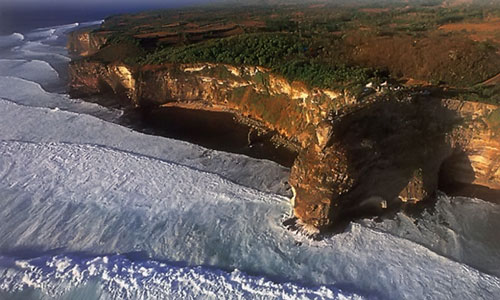 Pura Luhur Uluwatu is one of Bali's kayangan jagat (directional
temples) and guards Bali from evil spirits from the SW, in which dwell
major deities, in Uluwatu's case; Bhatara Rudra, God of the elements and
of cosmic force majeures. Bali's most spectacular temples located high
on a cliff top at the edge of a plateau 250 feet above the waves of the
Indian Ocean. Uluwatu lies at the southern tip of Bali in Badung
Regency. Dedicated to the spirits of the sea, the famous Pura Luhur
Uluwatu temple is an architectural wonder in black coral rock,
beautifully designed with spectacular views. This is a popular place to
enjoy the sunset. Famous not only for its unique position, Uluwatu also
boasts one of the oldest temples in Bali, Pura Uluwatu. Most of Bali's
regencies have Pura Luhur (literally high temples or ascension temples)
which become the focus for massive pilgrimages during three or five day
odalan anniversaries. The photogenic Tanah Lot and the Bat Cave temple,
Goa Lawah, is also Pura Luhur. Not all Pura Luhur are on the coast,
however but all have inspiring locations, overlooking large bodies of
water.
Pura Luhur Uluwatu is one of Bali's kayangan jagat (directional
temples) and guards Bali from evil spirits from the SW, in which dwell
major deities, in Uluwatu's case; Bhatara Rudra, God of the elements and
of cosmic force majeures. Bali's most spectacular temples located high
on a cliff top at the edge of a plateau 250 feet above the waves of the
Indian Ocean. Uluwatu lies at the southern tip of Bali in Badung
Regency. Dedicated to the spirits of the sea, the famous Pura Luhur
Uluwatu temple is an architectural wonder in black coral rock,
beautifully designed with spectacular views. This is a popular place to
enjoy the sunset. Famous not only for its unique position, Uluwatu also
boasts one of the oldest temples in Bali, Pura Uluwatu. Most of Bali's
regencies have Pura Luhur (literally high temples or ascension temples)
which become the focus for massive pilgrimages during three or five day
odalan anniversaries. The photogenic Tanah Lot and the Bat Cave temple,
Goa Lawah, is also Pura Luhur. Not all Pura Luhur are on the coast,
however but all have inspiring locations, overlooking large bodies of
water.Pura Uluwatu is located on the cliff top close to the famous surf break on the SW of the Bukit peninsula. Empu Kuturan, a Javanese Hindu priest who built the tiered meru, founded the temple in the 10th century and a shrine here as well as at other key locations longs the Balinese coast. In the 15th Century the great pilgrim priest Dhang Hyang Dwijendra, who established the present form of Hindu-Dharma religion, chose Pura Uluwatu as his last earthly abode: history records that Dwijendra achieved moksa (oneness with the godhead, in a flash of blazing light) while meditating at Uluwatu. The temple is regarded, by Brahman's island wide, as his holy 'tomb'. Legend also tells us that Dwijendra was the architect of the beautiful temple, as well as many other major temples on Bali, Lombok and Sumbawa. In the 17th century Niratha also from Java came to Bali and built temples, adding to Uluwatu.
Behind the main pagoda of Pura Uluwatu's small inner sanctum, a limestone statue of a Brahman priest surveys the Indian Ocean-it is said the statue represents the founding priest Dwijendra. Another shrine within the complex represents the boat on which Dwijendra traveled from, then, Hindu Java. According to legend he arrived at Pura Peti Tenget, north of Kuta.
Uluwatu Beach is known for its surf and, in nearby hostelries, its full moon rage parties. It rages at the temple too but in an orderly way, thanks to the royal house of Puri Agung Jero Kuta, Denpasar, who are the temple's hereditary pangemong (custodians). Hundreds of nobles from this family, and many 'devotees' (pengayah) and village pemangku priests from nearby hamlets, ensure that every seven months (on Anggar Kasih Medangsya by the Wuku Calendar, to be exact) the festival is run efficiently, and most elegantly. The palace is proud of its ancestral role: it manages the awesome logistics with fitting dignity.
Being a popular surfing spot for the very experienced, Uluwatu offers a wonderful vantage point to view a spectacular sunset. Warungs or small restaurants perched on the cliff offer a comfortable spot to survey the vast Indian Ocean beyond and below the 100-meter-high cliffs with panorama on three sides. Monkeys inhabit the temple and cliff face hoping for a banana or some peanuts from the visitors.
Gajah Cave (Goa Gajah)
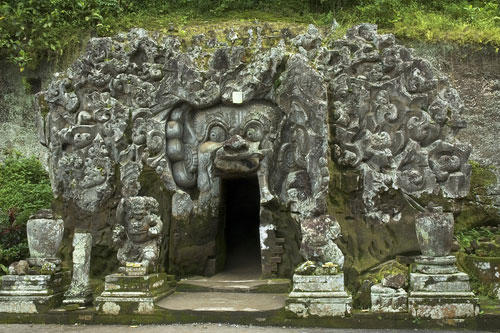 Goa Gajah, literally means 'Elephant Cave”. Although named by
'elephant' it doesn't mean there is any real elephant live or ever live
here. The name Goa Gajah derived from 'Lawa Gajah', which is mentioned
in the manuscripts that found in this site. This temple complex was
built for the first time around 11 century based on epigraph found in
this site.
Goa Gajah, literally means 'Elephant Cave”. Although named by
'elephant' it doesn't mean there is any real elephant live or ever live
here. The name Goa Gajah derived from 'Lawa Gajah', which is mentioned
in the manuscripts that found in this site. This temple complex was
built for the first time around 11 century based on epigraph found in
this site.A seven-meters deep cave with a shape of T-letter is the major attraction of this Bedulu village's local temple. The cave it self is carved in a solid stone hill of the river valley. The main figure of the carving at the cave entrance is 'boma', a barong face, accompanied with big clapping fingers on its side. Leaf, flower, and some horror figures can be noticed if we give more attention look to the rest of the carving. Some holes that are considered to be used as meditation or sleeping quarters can be found in the wall of the cave. Nowadays, those holes are used to place offerings whenever there is ceremonies taking place. On the left end side of the cave is Ganesha statue, believe it as 'the God of knowledge'. Meanwhile on the right end side can be found three 'linggas', that each of them dedicated to the three common God manifestations in Bali, Brahma, Wisnu, and Siwa. There are other three stone carvings in the centre wall, one of them figuring head and face.
Three other statues of Ganesha, demons and Men Brayut, a legendary lady with her beloved children, are placed on a high building located on the left side of cave entrance. It is considered that these statues are 1000 years old. In the middle of the complex, in front of the cave, there is bathing place that is not any longer used by the local people. The angle figures within the bathing complex are about similar to common figures found in India. On the south part of the complex, there are along flight of step leads down the lower part of the valley. After crossing a bridge above a small creek and follow another flight of steps up to eastern side of the valley, a headless sitting Buddha statue can be seen. This is the evident of a close relationship between the two religions.
Tidak ada komentar:
Posting Komentar